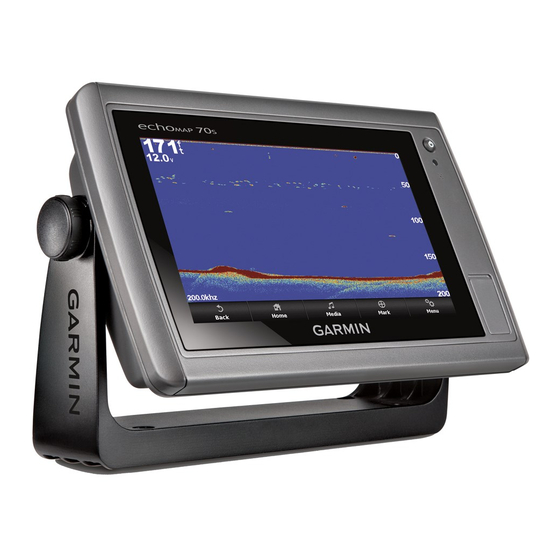Rings: Shows the range rings that help you to visualize
distances on the radar screen.
Nav. Lines: Shows the navigation lines that indicate the course
you have set using Route To, Guide To, or Go To.
Waypoints: Shows waypoints on the radar screen.
Front-of-Boat Offset
The front-of-boat offset compensates for the physical location of
the radar scanner on a boat, if the radar scanner does not align
with the bow-stern axis.
Measuring the Potential Front-of-Boat Offset
The front-of-boat offset compensates for the physical location of
the radar scanner on a boat, if the radar scanner does not align
with the bow-stern axis.
1
Using a magnetic compass, take an optical bearing of a
stationary target located within viewable range.
2
Measure the target bearing on the radar.
3
If the bearing deviation is more than +/- 1°, set the front-of-
boat offset.
Setting the Front-of-Boat Offset
Before you can set the front-of-boat offset, you must measure
the potential front-of-boat offset.
The front-of-boat offset setting configured for use in one radar
mode is applied to every other radar mode and to the Radar
overlay.
1
From a Radar screen or the Radar overlay, select Menu >
Radar Setup > Front of Boat.
2
Select Up or Down to adjust the offset.
Digital Selective Calling
Networked Chartplotter and VHF Radio
Functionality
If you have a NMEA 0183 VHF radio or a NMEA 2000 VHF
radio connected to your chartplotter, these features are
enabled.
• The chartplotter can transfer your GPS position to your radio.
If your radio is capable, GPS position information is
transmitted with DSC calls.
• The chartplotter can receive digital selective calling (DSC)
distress and position information from the radio.
• The chartplotter can track the positions of vessels sending
position reports.
If you have a Garmin NMEA 2000 VHF radio connected to your
chartplotter, these features are also enabled.
• The chartplotter allows you to quickly set up and send
individual routine call details to your Garmin VHF radio.
• When you initiate a man-overboard distress call from your
radio, the chartplotter shows the man-overboard screen and
prompts you to navigate to the man-overboard point.
• When you initiate a man-overboard distress call from your
chartplotter, the radio shows the Distress Call page to initiate
a man-overboard distress call.
Turning On DSC
Select Settings > Other Vessels > DSC.
DSC List
The DSC list is a log of the most recent DSC calls and other
DSC contacts you have entered. The DSC list can contain up to
100 entries. The DSC list shows the most recent call from a
boat. If a second call is received from the same boat, it replaces
the first call in the call list.
18
Viewing the DSC List
Before you can view the DSC list, the chartplotter must be
connected to a VHF radio that supports DSC.
Select Nav Info > Other Vessels > DSC List.
Adding a DSC Contact
You can add a vessel to your DSC list. You can make calls to a
DSC contact from the chartplotter.
1
Select Nav Info > Other Vessels > DSC List > Add
Contact.
2
Enter the Maritime Mobile Service Identity (MMSI) of the
vessel.
3
Enter the name of the vessel.
Incoming Distress Calls
If your Garmin chartplotter and VHF radio are connected using
NMEA 0183 or NMEA 2000, your chartplotter alerts you when
your VHF radio receives a DSC distress call. If position
information was sent with the distress call, that information is
also available and recorded with the call.
designates a distress call in the DSC list and marks the
position of the vessel on the Navigation chart at the time of the
DSC distress call.
Navigating to a Vessel in Distress
designates a distress call in the DSC list and marks the
position of a vessel on the Navigation chart at the time of the
DSC distress call.
1
Select Nav Info > Other Vessels > DSC List.
2
Select a position-report call.
3
Select Navigate To.
4
Select Go To or Route To.
Man-Overboard Distress Calls Initiated from a VHF
Radio
When your chartplotter is connected to a Garmin NMEA 2000
compatible radio, and you initiate a man-overboard DSC
distress call from your radio, your Garmin chartplotter shows the
man-overboard screen and prompts you to navigate to the man-
overboard point. If you have a Garmin autopilot system
connected to the network, your chartplotter prompts you to start
a Williamson's turn to the man-overboard point.
If you cancel the man-overboard distress call on the radio, the
chartplotter screen prompting you to activate navigation to the
man-overboard location disappears.
Man-Overboard Distress Calls Initiated from the
Chartplotter
When your chartplotter is connected to a Garmin NMEA 2000
compatible radio and you activate navigation to a man-
overboard location, the radio shows the Distress Call page so
you can quickly initiate a man-overboard distress call.
For information on placing distress calls from your radio, see the
VHF radio owner's manual. For information about marking an
MOB, see
page
8.
Position Tracking
When you connect your Garmin chartplotter to a VHF radio
using NMEA 0183, you can track vessels that send position
reports. This feature is also available with NMEA 2000, when
the vessel sends the correct PGN data (PGN 129808; DSC Call
Information).
Every position report call received is logged in the DSC list
(page
18).
Viewing a Position Report
1
Select Nav Info > Other Vessels > DSC List.
Digital Selective Calling

